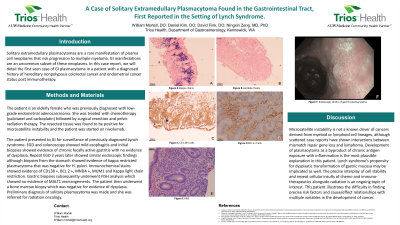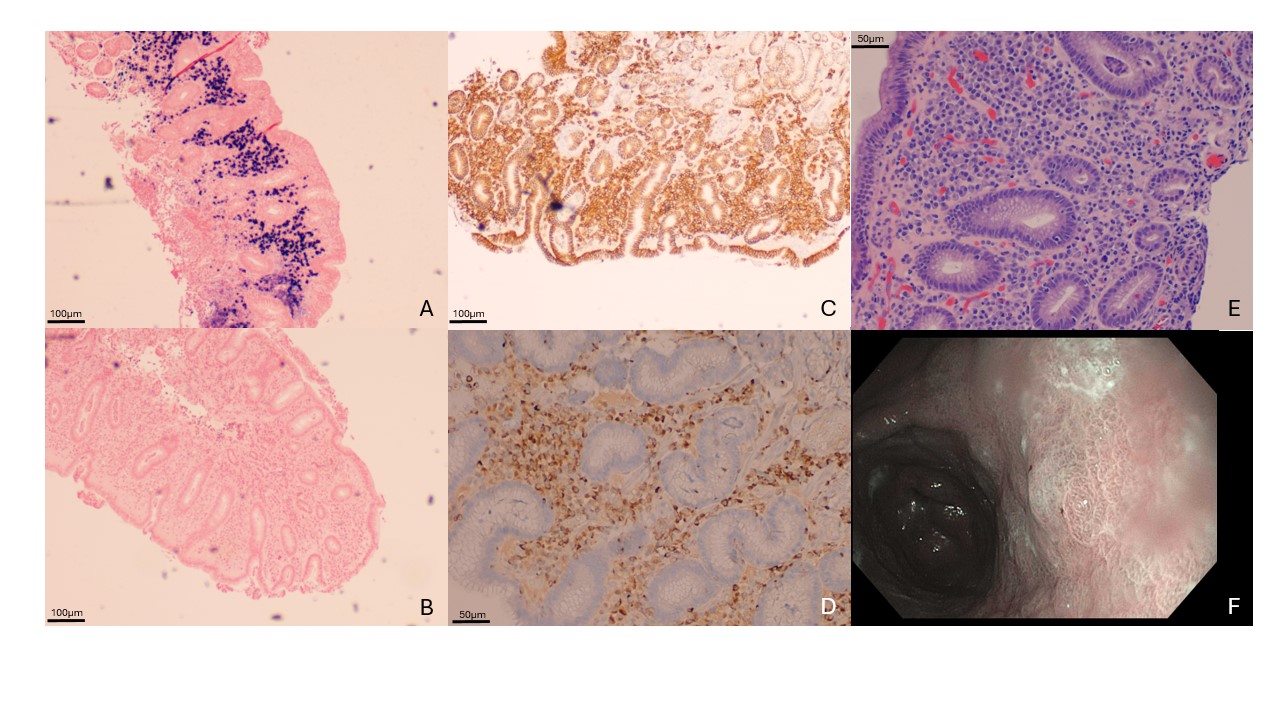Monday Poster Session
Category: Stomach
P3414 - A Case of Solitary Extramedullary Plasmacytoma Found in the Gastrointestinal Tract First Reported in the Setting of Lynch Syndrome.
Monday, October 28, 2024
10:30 AM - 4:00 PM ET
Location: Exhibit Hall E

Has Audio

William Mortell, DO
Trios Health
Kennewick, WA
Presenting Author(s)
William Mortell, DO1, Daniel Kim, DO1, Ningxin Zeng, MD1, David Fink, DO2
1Trios Health, Kennewick, WA; 2Incyte Diagnostics, Kennewick, WA
Introduction: Solitary extramedullary plasmacytomas are a rare manifestation of plasma cell neoplasms that risk progression to multiple myeloma. GI manifestations are an uncommon subset of these neoplasms. In this case report, we will detail the first seen case of GI plasmacytoma in a patient with a diagnosed history of hereditary nonpolyposis colorectal cancer and endometrial cancer status post immunotherapy.
Case Description/Methods: The patient is an elderly female who was previously diagnosed with low-grade endometrial adenocarcinoma. She was treated with chemotherapy (palcitaxel and carboplatin) followed by surgical resection and pelvic radiation therapy. The resected tissue was found to be positive for microsatellite instability and the patient was started on nivolumab.
The patient presented to GI for surveillance of previously diagnosed Lynch syndrome. EGD and colonoscopy showed mild esophagitis and initial biopsies showed evidence of chronic focally active gastritis with no evidence of dysplasia. Repeat EGD 2 years later showed similar endoscopic findings although biopsies from the stomach showed evidence of kappa restricted plasmacytoma that was negative for H. pylori. Immunochemical stains showed evidence of CD138 +, BCL 2 +, MNDA +, MUM1 and Kappa light chain restriction. Gastric biopsies subsequently underwent FISH analysis which showed no evidence of MALT1 rearrangements. Patient then underwent a bone marrow biopsy which was negative for evidence of dysplasia. Preliminary diagnosis of solitary plasmacytoma was made and she was referred for radiation oncology.
Discussion: Microsatellite instability is not a known driver of cancers derived from myeloid or lymphoid cell lineages, although scattered case reports have shown interactions between mismatch repair gene loss and lymphoma. Development of plasmacytoma as a byproduct of chronic antigen exposure with inflammation is the most plausible explanation in this patient. Lynch syndrome’s propensity for dysplastic transformation of gastric mucosa may be implicated as well. The precise interplay of cell stability and repeat cellular insults of chemo and immunotherapeutics alongside radiation is an ongoing topic of interest. This patient illustrates the difficulty in finding precise risk factors and cause/effect relationships with multiple variables in the development of cancer.

Disclosures:
William Mortell, DO1, Daniel Kim, DO1, Ningxin Zeng, MD1, David Fink, DO2. P3414 - A Case of Solitary Extramedullary Plasmacytoma Found in the Gastrointestinal Tract First Reported in the Setting of Lynch Syndrome., ACG 2024 Annual Scientific Meeting Abstracts. Philadelphia, PA: American College of Gastroenterology.
1Trios Health, Kennewick, WA; 2Incyte Diagnostics, Kennewick, WA
Introduction: Solitary extramedullary plasmacytomas are a rare manifestation of plasma cell neoplasms that risk progression to multiple myeloma. GI manifestations are an uncommon subset of these neoplasms. In this case report, we will detail the first seen case of GI plasmacytoma in a patient with a diagnosed history of hereditary nonpolyposis colorectal cancer and endometrial cancer status post immunotherapy.
Case Description/Methods: The patient is an elderly female who was previously diagnosed with low-grade endometrial adenocarcinoma. She was treated with chemotherapy (palcitaxel and carboplatin) followed by surgical resection and pelvic radiation therapy. The resected tissue was found to be positive for microsatellite instability and the patient was started on nivolumab.
The patient presented to GI for surveillance of previously diagnosed Lynch syndrome. EGD and colonoscopy showed mild esophagitis and initial biopsies showed evidence of chronic focally active gastritis with no evidence of dysplasia. Repeat EGD 2 years later showed similar endoscopic findings although biopsies from the stomach showed evidence of kappa restricted plasmacytoma that was negative for H. pylori. Immunochemical stains showed evidence of CD138 +, BCL 2 +, MNDA +, MUM1 and Kappa light chain restriction. Gastric biopsies subsequently underwent FISH analysis which showed no evidence of MALT1 rearrangements. Patient then underwent a bone marrow biopsy which was negative for evidence of dysplasia. Preliminary diagnosis of solitary plasmacytoma was made and she was referred for radiation oncology.
Discussion: Microsatellite instability is not a known driver of cancers derived from myeloid or lymphoid cell lineages, although scattered case reports have shown interactions between mismatch repair gene loss and lymphoma. Development of plasmacytoma as a byproduct of chronic antigen exposure with inflammation is the most plausible explanation in this patient. Lynch syndrome’s propensity for dysplastic transformation of gastric mucosa may be implicated as well. The precise interplay of cell stability and repeat cellular insults of chemo and immunotherapeutics alongside radiation is an ongoing topic of interest. This patient illustrates the difficulty in finding precise risk factors and cause/effect relationships with multiple variables in the development of cancer.

Figure: Gastric biopsy samples stained for/with:
A) Kappa chains
B) Lambda chains
C) CD 138+ cells
D) BCL 2+ cells
E) H&E
F) Endoscopic photo of Gastric Plasmacytoma
A) Kappa chains
B) Lambda chains
C) CD 138+ cells
D) BCL 2+ cells
E) H&E
F) Endoscopic photo of Gastric Plasmacytoma
Disclosures:
William Mortell indicated no relevant financial relationships.
Daniel Kim indicated no relevant financial relationships.
Ningxin Zeng indicated no relevant financial relationships.
David Fink indicated no relevant financial relationships.
William Mortell, DO1, Daniel Kim, DO1, Ningxin Zeng, MD1, David Fink, DO2. P3414 - A Case of Solitary Extramedullary Plasmacytoma Found in the Gastrointestinal Tract First Reported in the Setting of Lynch Syndrome., ACG 2024 Annual Scientific Meeting Abstracts. Philadelphia, PA: American College of Gastroenterology.
